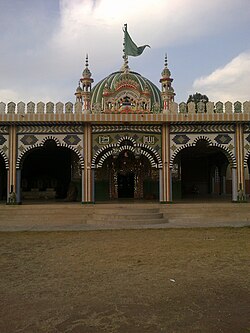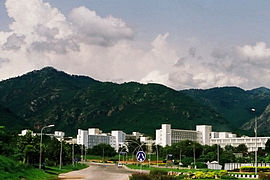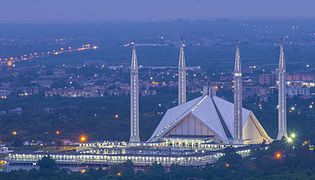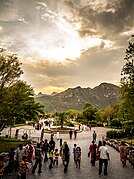Islamabad Capital Territory
The area was separated from Rawalpindi District in 1967 to form a separate territory administered by the federal government. The territory is represented in the National Assembly by NA-52, NA-53, and NA-54 constituencies and by four seats in the Senate.
History
In 1960, land was transferred from Rawalpindi District of Punjab province to replace Karachi Federal Capital Territory and establish Pakistan's new capital. According to the 1960s master plan, the Capital Territory included Rawalpindi, and was to be composed of the following parts:
- Rawalpindi, 259 square kilometres (100 sq mi)
- Islamabad Urban, 220.15 square kilometres (85.00 sq mi)
- Margalla Hills, 220.15 square kilometres (85.00 sq mi)
- Islamabad Rural, 466.20 square kilometres (180.00 sq mi)
However, Rawalpindi was eventually excluded from the Islamabad master plan in the 1980s.
Administration

Zones

Islamabad is subdivided into five zones:
- Zone I: Designated for urban development and federal government institutions
- Zone II: Designated for urban development
- Zone III: Designated for rural development
- Zone IV: Designated for rural development
- Zone V: Designated for rural development
Sectors
Union councils

Islamabad Capital Territory comprises urban and rural areas. The rural consists of 23 union councils, comprising 133 villages, while urban has 27 union councils.
| UC # | Chief locality | Localities within jurisdiction |
|---|---|---|
| 1 | Saidpur | Said Pur, Gokina, Talhar |
| 2 | Noorpur Shahan | Noorpur Shahan, Ratta Hutar |
| 3 | Mal Pur | Mal Pur, Romali, Nariyas, Phadu, Shahdrah Khurd, Shahdrah Kalan, Mandala, Jang Begial, Subban Syedan, Mangial, Quaid-e-Azam University |
| 4 | Kot Hathial (Shamal) | Kot Hathial, Bhara Kahu, Nayiabadi, Muhallah Alnoor, Muhallah Ban, Muhallah Malkan, Dhok Syedan |
| 5 | Kot Hathial (Janoob) | Kot Hathial, Nainsukh, Barakahu, Behra Syedan, Muhallah Ghousia, Sharak-e-Madina, Dhok Jilani, Muhallah Malikabad |
| 6 | Phulgran | Phulgran, Phul Garan, Dhok Kuch, Abbasiabad, Dhok Badhan, Muhallah Kangar, Mahallah Ranjpuran, Shahpur, Bobry, Karlot Chattar, Mohra Rajpoota, Muhallah Sumbul, Bani Gala |
| 7 | Pind Begwal | Pind Begwal, Bainala, Maira Biguwal, Atthal, Dhok Sajjal, Dhok Nanda Sihali, Jandala, Simli |
| 8 | Tumair | Tumair, Pihont, Chakhtan, Darkalam, Kanjnah |
| 9 | Charah | Charah, Dhok Maira, Dhok Las, Kiani, Dhok Haveli |
| 10 | Kirpa | Kirpa, Ladhiot Syedan, Pind Malikan, Dhok Ban, Bhimbar Tarar, Mahallah Haveli Rajgan, Mehfozabad, Chaniol, Muhallah Chaudrian, Ara, Gora Mast, Dhok Jogian Harnu, Chauntra Sogran |
| 11 | Mughal | Mughal, Hardoghar, Kangota Gujjran Sihala, Hondamial, Nara Syedan, Chuchkal Chakiyan, Chak Kamdar |
| 12 | Rawat | Rawat, Bhangrial Kalan, Banni Saran, Mohra Nagial, Sawan, Bagga Shaikhan |
| 13 | Humak | Humak, Kaniyal, Gora Syedan, Niazian |
| 14 | Sihala | Sihala Khurd, Maira Dakhli, Bhandar Sihala, Jarki Sihala, Gagri Sihala, Jhundla, Kangota Syedan, Gura Mistriyan |
| 15 | Lohi Bhair | Lohi Bhar, Shahrak-e-Korang, Bagh-e-Sawan, Shahrak-e-Pakistan |
| 16 | Darwala | Darwala, Dhaliala, Panwal, Chucha Sheikhiyan, Bhair, Kanghar, Sher Ghamial, Dhok Kavgar, Kathrial, Chucha, Dhok Kashimiriya, Harn maira, Malali, Bun koutha, Pahg Panwal, Farash, Bangiyal |
| 17 | Koral | Koral, Tarlai Khurd, Gangal, Chaklala, Shareefabad, Gohra Sardar, Tarlai |
| 18 | Khana Dak | Khana Dak, Dhok Jabba, Pindorian, Shahrak-e-Bilal, Shahrak-e-Barma, Shahrak-e-Madina, Muhallah Wahid Abad, Shahrak-e-Masih) |
| 19 | Tarlai Kalan | Tarlai Kalan, Irfanabad, Chappar Meer Khanal, Sahana |
| 20 | Ali Pur | Ali Pur, Alipur,Jhang Syedan,Partal, Khadrapar, Farash, |
| 21 | Sohan | Sohan Dehati, Khana Kak, Shakrial, Shakrial (Sharki) |
| 22 | Chak Shahzad | Chak Shahzad, Chak Bihra Shigh, Jaba Teli, Sohana, Pandori, Chhatta Bakhtawar, Bohan, Dhoke Sharaf, Mujuhan |
| 23 | Kuri | Kuri, Malot, Rakh Bani Gala, Rihara, Mohra Jujan |
| 24 | Shahrak-e-Rawal | Shahrak-e-Rawal, Shahrak-e-Margala, Sumbal Korakh, Puna Faqeeran, Mohrian |
| 25 | Sector F-6 | F-6/1, F-6/2, F-6/3, F-6/4, Farooqi Bazar, Madni Masjid, Dhobi Gat |
| 26 | Sector G-6/1 | |
| 27 | Sector G-6 | Sector G-6/2, Sector G-6/3 & Sector G-6/4 |
| 28 | Sector F-7, F-8, F-9 | |
| 29 | Sector F-10, F-11 | |
| 30 | Sector G-7/3, G-7/4 | |
| 31 | Sector G-7/1, G-7/2 | |
| 32 | Sector G-8/3, G-8/4 | |
| 33 | Sector G-8/1, G-8/2 | |
| 34 | Sector G-9 | Sector G-9/1, G-9/3, G-9/4 |
| 35 | Sector G-9/2 | |
| 36 | Sector G-10/3, G-10/4 | |
| 37 | Sector G-10/1, G-10/2 | |
| 38 | Sector G-11 | Sector G-11/1, G-11/2, G-11/3, G-11/4 |
| 39 | Maira Sumbal Jaffar | Maira Sumbal Jaffar, Golra Sharif, Badia Rusmat Khan, Maira Akku, Dhareek Mohri, Shahrak-e-Effaq |
| 40 | G-13 | |
| 40 | Sector I-8 | Sector I-8/1,I8/2,I8/3,I8/4 |
| 41 | Sector I-9 | |
| 42 | Sector I-10/1 | |
| 43 | Sector I-10 | Sector I-10/2, I-10/3, I-10/4 |
| 44 | Bokra | Bokra, Haji Complex, Soria Harboza, Mouza Sorain, Peer Wadhai, Shahrak-e-Iqbal |
| 45 | Jhangi Saydan | |
| 46 | Village Noon | Badhana Kalan, Dhoke Makhan, ETC |
| 47 | Tarnol | |
| 48 | Sarai Kharbooza | |
| 49 | Shah Allah Ditta | |
| 50 | Golra Sharif |
Climate

Seasons
The climate of Islamabad has a humid subtropical climate (Köppen: Cwa), with five seasons: winter (November–February), spring (March and April), summer (May and June), rainy monsoon (July and August), and autumn (September and October).
Temperatures
The temperatures range from 13 °C (55 °F) in January to 38 °C (100 °F) in June. The hottest month is June, where average highs routinely exceed 38 °C (100.4 °F), while the coolest month is January. The highest recorded temperature was 46.6 °C (115.9 °F) on 23 June 2005 while the lowest temperature was −6 °C (21.2 °F) on 17 January 1967. Winters generally feature dense fog in the mornings and sunny afternoons. In the city, temperatures stay mild, with snowfall over the higher elevations points on nearby hill stations, notably Murree and Nathia Gali.
Precipitation
The wettest month is July, with heavy rainfalls and evening thunderstorms with the possibility of cloudburst and flooding. Highest monthly rainfall of 743.3 millimetres (29.26 in) was recorded during July 1995. On 23 July 2001, Islamabad received a record breaking 620 millimetres (24 in) of rainfall in just 10 hours. It was the heaviest rainfall in Islamabad in the past 100 years and the highest rainfall in 24 hours as well. The city has also experienced snowfall on a number of occasions. Islamabad's micro-climate is regulated by three artificial reservoirs: Rawal, Simli, and Khanpur Dam. The latter is located on the Haro River near the town of Khanpur, about 40 kilometres (25 mi) from Islamabad. Simli Dam is 30 kilometres (19 mi) north of Islamabad.
Vegetation
Around 220 acres (89 ha) of the city consists of the Margalla Hills National Park, while the Loi Bher Forest is situated along the Islamabad Highway, covering an area of 1,087 acres (440 ha).
| Climate data for Islamabad (1991-2020) | |||||||||||||
|---|---|---|---|---|---|---|---|---|---|---|---|---|---|
| Month | Jan | Feb | Mar | Apr | May | Jun | Jul | Aug | Sep | Oct | Nov | Dec | Year |
| Record high °C (°F) | 25.0 (77.0) |
30.0 (86.0) |
37.0 (98.6) |
44.0 (111.2) |
45.6 (114.1) |
48.6 (119.5) |
45.0 (113.0) |
42.0 (107.6) |
38.1 (100.6) |
38.0 (100.4) |
32.2 (90.0) |
28.3 (82.9) |
48.6 (119.5) |
| Mean daily maximum °C (°F) | 17.7 (63.9) |
20.0 (68.0) |
24.8 (76.6) |
30.6 (87.1) |
36.1 (97.0) |
38.3 (100.9) |
35.4 (95.7) |
33.9 (93.0) |
33.4 (92.1) |
30.9 (87.6) |
25.4 (77.7) |
20.4 (68.7) |
28.9 (84.0) |
| Daily mean °C (°F) | 10.7 (51.3) |
13.4 (56.1) |
18.1 (64.6) |
23.6 (74.5) |
28.7 (83.7) |
31.4 (88.5) |
30.1 (86.2) |
29.1 (84.4) |
27.6 (81.7) |
23.3 (73.9) |
17.3 (63.1) |
12.5 (54.5) |
22.2 (71.9) |
| Mean daily minimum °C (°F) | 2.2 (36.0) |
6.8 (44.2) |
11.4 (52.5) |
16.6 (61.9) |
21.5 (70.7) |
24.5 (76.1) |
24.9 (76.8) |
24.2 (75.6) |
21.7 (71.1) |
15.6 (60.1) |
9.1 (48.4) |
3.4 (38.1) |
15.2 (59.3) |
| Record low °C (°F) | −10 (14) |
−8 (18) |
−4.5 (23.9) |
1.6 (34.9) |
5.5 (41.9) |
13 (55) |
15.2 (59.4) |
14.5 (58.1) |
13.3 (55.9) |
5.7 (42.3) |
−0.6 (30.9) |
−2.8 (27.0) |
−6.0 (21.2) |
| Average precipitation mm (inches) | 55.2 (2.17) |
99.5 (3.92) |
180.5 (7.11) |
120.8 (4.76) |
39.9 (1.57) |
78.4 (3.09) |
310.6 (12.23) |
317.0 (12.48) |
135.4 (5.33) |
34.4 (1.35) |
17.7 (0.70) |
25.9 (1.02) |
1,415.3 (55.73) |
| Average precipitation days (≥ 1.0 mm) | 4.7 | 8 | 9 | 9 | 5.2 | 6.0 | 12.3 | 11.9 | 6.4 | 2.9 | 2.0 | 2.0 | 79.4 |
| Mean monthly sunshine hours | 195.7 | 187.1 | 202.3 | 252.4 | 319.0 | 300.1 | 264.4 | 250.7 | 262.2 | 275.5 | 247.9 | 195 | 2,952.3 |
| Source 1: NOAA (sun, 1961-1990) | |||||||||||||
| Source 2: PMD (extremes) | |||||||||||||
Cityscape
Civic administration
The main administrative authority of the city is Islamabad Capital Territory Administration with some help from Metropolitan Corporation Islamabad and Capital Development Authority (CDA), which oversees the planning, development, construction, and administration of the city. Islamabad Capital Territory is divided into eight zones: Administrative Zone, Commercial District, Educational Sector, Industrial Sector, Diplomatic Enclave, Residential Areas, Rural Areas and Green Area.
Islamabad city is divided into five major zones: Zone I, Zone II, Zone III, Zone IV, and Zone V. Out of these, Zone IV is the largest in area. All sectors of Ghouri Town (1, 2, 3, VIP, 5, 4-A, 4-B, 4-C, 5-A, 5-B and sector 7) are located in this zone. Zone I consists mainly of all the developed residential sectors, while Zone II consists of the under-developed residential sectors. Each residential sector is identified by a letter of the alphabet and a number, and covers an area of approximately 4 square kilometres. The sectors are lettered from A to I, and each sector is divided into four numbered sub-sectors.
Sectors
Series A, B, and C are still underdeveloped. The D series has seven sectors (D-11 to D-17), of which only sector D-12 is completely developed. This series is located at the foot of Margalla Hills. The E Sectors are named from E-7 to E-17. Many foreigners and diplomatic personnel are housed in these sectors. In the revised Master Plan of the city, CDA has decided to develop a park on the pattern of Fatima Jinnah Park in sector E-14. Sectors E-8 and E-9 contain the campuses of Bahria University, Air University, and the National Defence University. The F and G series contains the most developed sectors. F series contains sectors F-5 to F-17; some sectors are still under-developed. F-5 is an important sector for the software industry in Islamabad, as the two software technology parks are located here. The entire F-9 sector is covered with Fatima Jinnah Park. The Centaurus complex will be one of the major landmarks of the F-8 sector. G sectors are numbered G-5 through G-17. Some important places include the Jinnah Convention Center and Serena Hotel in G-5, the Red Mosque in G-6, and the Pakistan Institute of Medical Sciences, the largest medical complex in the capital, located in G-8.
The H sectors are numbered H-8 through H-17. The H sectors are mostly dedicated to educational and health institutions. National University of Sciences and Technology covers a major portion of sector H-12. The I sectors are numbered from I-8 to I-18. With the exception of I-8, which is a well-developed residential area, these sectors are primarily part of the industrial zone. Currently two sub-sectors of I-9 and one sub-sector of I-10 are used as industrial areas. CDA is planning to set up Islamabad Railway Station in Sector I-18 and Industrial City in sector I-17. Zone III consists primarily of the Margalla Hills and Margalla Hills National Park. Rawal Lake is in this zone. Zone IV and V consist of Islamabad Park, and rural areas of the city. The Soan River flows into the city through Zone V.
Demographics
According to the 2023 Census, Islamabad Capital Territory had a population of 2,363,863.
| Census Year | Population |
| 1972 | 237,549 |
| 1981 | 340,286 |
| 1998 | 805,235 |
| 2017 | 2,003,368 |
| 2023 | 2,363,863 |
Language
According to 2023 Pakistani census, there are 1,154,540 Punjabi, 415,838 Pashto, 358,922 Urdu, 140,780 Hindko, 51,920 Kashmiri, 46,270 Saraiki, 21,362 Sindhi, 10,315 Balti, 7,099 Shina, 5,016 Koshistani, 4,503 Balochi, 1,095 Mewati, 668 Brahvi, 182 Kalasha and 64,734 others, of total 2,283,244 speakers.
After Islamabad's establishment, people from all around Pakistan shifted here which led to a diverse demographics. But, Punjabis still constitute the single largest ethnic population in the territory.
Religion
Religion in Islamabad Territory, Pakistan
Islam is the largest and most practiced religion in the territory, with over 96% of the population adhering to the faith. Christianity is the second largest religion and forms 2.8% of the population. Ahmedis make up 0.11%. Other minorities, like Sikhs and Hindus, form just 0.2% combined.
Islamabad-Rawalpindi metropolitan area
When the master plan for Islamabad was drawn up in 1960, Islamabad and Rawalpindi, along with the adjoining areas, was to be integrated to form a large metropolitan area called Islamabad/Rawalpindi Metropolitan Area. The area would consist of the developing Islamabad, the old colonial cantonment city of Rawalpindi, and Margalla Hills National Park, including surrounding rural areas. However, Islamabad city is part of the Islamabad Capital Territory, while Rawalpindi is part of Rawalpindi District, which is part of province of Punjab.
-
Chaghi Monument
-
Pakistan Secretariat
-
Star and Crescent Monument near the start of Shakarparian
-
Daman-e-Koh Park
-
Sunset over the Lake View Park
-
View of Blue Area, the commercial hub of the city.







